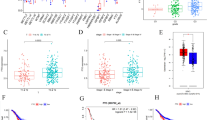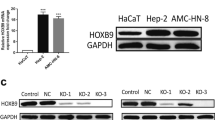Abstract
Accumulating evidence has implicated that constitutive activation of signal transducer and activator of transcription protein 3 (STAT3) may be a major oncogenic factor involved in hepatocellular carcinoma (HCC) development. Gene associated with retinoid-interferon-induced mortality-19 (GRIM-19) has been shown to be a tumor suppressor associated with growth control and suppression of STAT3 activity. The downregulation of GRIM-19 expression has been shown in a number of human tumor types, and it has been correlated with hyperactivation of STAT3. However, the role of GRIM-19 in the pathogenesis of HCC has not been evaluated. The aim of our study was to evaluate GRIM-19 expression levels and investigate their correlation with phosphorylated STAT3 (p-STAT3) levels in HCC. GRIM-19 and p-STAT3 expression levels were analyzed in HCC and adjacent nontumorous liver tissues (ANLT) by immunohistochemistry, western blot analysis, and RT-PCR. GRIM-19 protein expression was predominantly located in the cytoplasm with weak staining in the nucleus in ANLT, but only located in the cytoplasm in HCC tissues. HCC samples exhibited low levels of GRIM-19 and moderate to high levels of p-STAT3 expression. In contrast, ANLT was characterized by high levels of GRIM-19 and low levels of p-STAT3 expression. Downregulation of GRIM-19 was closely correlated with increased histological grade in HCC. GRIM-19 expression is closely correlated with histological grading and p-STAT3 in HCC. Thus, the potential role of GRIM-19 in HCC development may be through these correlations.





Similar content being viewed by others
References
El-Serag HB. Hepatocellular carcinoma: an epidemiologic view. J Clin Gastroenterol. 2002;35:S72–8.
Gao B. Cytokines, STATs and liver disease. Cell Mol Immunol. 2005;2:92–100.
Taub R. Hepatoprotection via the IL-6/Stat3 pathway. J Clin Invest. 2003;112:978–80.
Berclaz G, Altermatt HJ, Rohrbach V, et al. EGFR dependent expression of Stat3 (but not STAT1) in breast cancer. Int J Oncol. 2001;19:1155–60.
Fernandes A, Hamburger AW, Gerwin BI. Erb-2 kinase is required for constitutive stat 3 activation in malignant human lung epithelial cells. Int J Cancer. 1999;83:564–70.
Campbell CL, Jiang Z, Savarese DM, et al. Increased expression of the interleukin-11 receptor and evidence of Stat3 activation in prostate carcinoma. Am J Pathol. 2001;158:25–32.
Huang M, Page C, Reynolds RK, et al. Constitutive activation of stat3 oncogene product in human ovarian carcinoma cells. Gynecol Oncol. 2000;79:67–73.
Niu G, Bowman T, Huang M, et al. Roles of activated Src and Stat3 signaling in melanoma tumor cell growth. Oncogene. 2002;21:7001–10.
Wei D, Le X, Zheng L, et al. Stat3 activation regulates the expression of vascular endothelial growth factor and human pancreatic cancer angiogenesis and metastasis. Oncogene. 2003;22:319–29.
Haura EB, Turkson J, Jove R. Mechanisms of disease: insights into the emerging role of signal transducers and activators of transcription in cancer. Nat Clin Pract Oncol. 2005;2:315–24.
Calo V, Migliavacca M, Bazan V, et al. STAT proteins: from normal control of cellular events to tumorigenesis. J Cell Physiol. 2003;197:157–68.
Waris G, Huh KW, Siddiqui A. Mitochondrially associated hepatitis B virus X protein constitutively activates transcription factors STAT-3 and NF-kappa B via oxidative stress. Mol Cell Biol. 2001;21:7721–30.
Waris G, Siddiqui A. Regulatory mechanisms of viral hepatitis B and C. J Biosci. 2003;28:311–21.
Yoshida T, Hanada T, Tokuhisa T, et al. Activation of STAT3 by the hepatitis C virus core protein leads to cellular transformation. J Exp Med. 2002;196:641–53.
Gong G, Waris G, Tanveer R, et al. Human hepatitis C virus NS5A protein alters intracellular calcium levels, induces oxidative stress, and activates STAT-3 and NF-kappa B. Proc Natl Acad Sci USA. 2001;98:9599–604.
Arbuthnot P, Capovilla A, Kew M. Putative role of hepatitis B virus X protein in hepatocarcinogenesis: effects on apoptosis, DNA repair, mitogen-activated protein kinase and JAK/STAT pathways. J Gastroenterol Hepatol. 2000;15:357–68.
Sarcar B, Ghosh AK, Steele R, et al. Hepatitis C virus NS5A mediated STAT3 activation requires co-operation of Jak1 kinase. Virology. 2004;322:51–60.
Sanchez A, Nagy P, Thorgeirsson SS. STAT-3 activity in chemically-induced hepatocellular carcinoma. Eur J Cancer. 2003;39:2093–8.
Angell JE, Lindner DJ, Shapiro PS, Hofmann ER, Kalvakolanu DV. Identification of GRIM-19, a novel cell death-regulatory gene induced by the interferon-beta and retinoic acid combination, using a genetic approach. J Biol Chem. 2000;275:33416–26.
Lufei C, Ma J, Huang G, et al. GRIM-19, a death-regulatory gene product, suppresses Stat3 activity via functional interaction. EMBO J. 2003;17:1325–35.
Kalakonda S, Nallar SC, Lindner DJ, Hu J, Reddy SP, Kalvakolanu DV. Tumor-suppressive activity of the cell death activator GRIM-19 on a constitutively active signal transducer and activator of transcription 3. Cancer Res. 2007;67(13):6212–20.
Bromberg JF, Wrzeszczynska MH, Devgan G, et al. Stat3 as an oncogene. Cell. 1999;98(3):295–303.
Alchanati I, Nallar SC, Sun P, et al. A proteomic analysis reveals the loss of expression of the cell death regulatory gene GRIM-19 in human renal cell carcinomas. Oncogene. 2006;25:7138–47.
Peroukides S, Bravou V, Varakis J, Alexopoulos A, Kalofonos H, Papadaki H. ILK overexpression in human hepatocellular carcinoma and liver cirrhosis correlates with activation of Akt. Oncol Rep. 2008;20:1337–44.
Huang G, Lu H, Hao A, et al. GRIM-19, a cell death regulatory protein, is essential for assembly and function of mitochondrial complex I. Mol Cell Biol. 2004;19:8447–56.
Gong LB, Luo XL, Liu SY, Tao DD, Gong JP, Hu JB. Correlations of GRIM-19 and its target gene product STAT3 to malignancy of human colorectal carcinoma. Aizheng. 2007;26(7):683–7 (in Chinese).
Zhang J, Yang J, Roy SK, et al. The cell death regulator GRIM-19 is an inhibitor of signal transducer and activator of transcription 3. Proc Natl Acad Sci USA. 2003;100:9342–7.
Zhou Y, Li M, Wei Y, et al. Down-Regulation of GRIM-19 Expression Is Associated With Hyperactivation of STAT3-Induced Gene Expression and Tumor Growth in Human Cervical Cancers. J Interferon Cytokine Res. 2009;29(10):695–703.
Inghirami G, Chiarle R, Simmons WJ, Piva R, Schlessinger K, Levy DE. New and old functions of STAT3: a pivotal target for individualized treatment of cancer. Cell Cycle. 2005;4(9):1131–3.
Niu G, Bowman T, Huang M, et al. Roles of activated Src and Stat3 signaling in melanoma tumor cell growth. Oncogene. 2002;21:7001–10.
Wei D, Le X, Zheng L, et al. Stat3 activation regulates the expression of vascular endothelial growth factor and human pancreatic cancer angiogenesis and metastasis. Oncogene. 2003;22:319–29.
Haura EB, Turkson J, Jove R. Mechanisms of disease: insights into the emerging role of signal transducers and activators of transcription in cancer. Nat Clin Pract Oncol. 2005;2:315–24.
Gong W, Wang L, Yao JC, et al. Expression of activated signal transducer and activator of transcription 3 predicts expression of vascular endothelial growth factor in and angiogenic phenotype of human gastric cancer. Clin Cancer Res. 2005;11:1386–93.
Hsieh FC, Cheng G, Lin J. Evaluation of potential Stat3-regulated genes in human breast cancer. Biochem Biophys Res Commun. 2005;335:292–9.
Chen H, Ye D, Xie X, Chen B, Lu W. VEGF, VEGFRs expressions and activated STATs in ovarian epithelial carcinoma. Gynecol Oncol. 2004;94:630–5.
Kalvakolanu DV. The GRIMs: a new interface between cell death regulation and interferon/retinoid induced growth suppression. Cytokine Growth Factor Rev. 2004;15(2–3):169–94.
Hu J, Angell JE, Zhang J, et al. Characterization of monoclonal antibodies against GRIM-19, a novel IFN-beta and retinoic acid-activated regulator of cell death. J Interferon Cytokine Res. 2002;22:1017–26.
Zhang X, Huang Q, Yang Z, Li Y, Li CY. GW112, a novel antiapoptotic protein that promotes tumor growth. Cancer Res. 2004;64:2474–81.
Agostino DM, Bernardi P, Chieco-Bianchi L, Ciminale V. Mitochondria as functional targets of proteins coded by human tumor viruses. Adv Cancer Res. 2005;94:87–142.
Seo T, Lee D, Shim YS, et al. Viral interferon regulatory factor 1 of Kaposi’s sarcoma-associated herpesvirus interacts with a cell death regulator, GRIM19, and inhibits interferon/retinoic acid-induced cell death. J Virol. 2002;76:8797–807.
Acknowledgments
This work was supported by Grant No. 2007BS03005 from the Shandong Science and Technology Committee of China. We also thank Medjaden Bioscience Limited for assisting in the preparation of this manuscript.
Conflict of interest
None.
Author information
Authors and Affiliations
Corresponding author
Rights and permissions
About this article
Cite this article
Li, F., Ren, W., Zhao, Y. et al. Downregulation of GRIM-19 is associated with hyperactivation of p-STAT3 in hepatocellular carcinoma. Med Oncol 29, 3046–3054 (2012). https://doi.org/10.1007/s12032-012-0234-8
Received:
Accepted:
Published:
Issue Date:
DOI: https://doi.org/10.1007/s12032-012-0234-8




